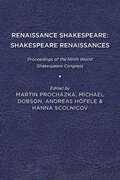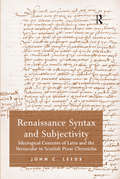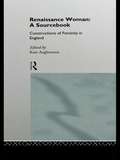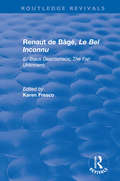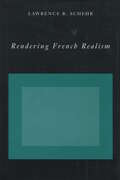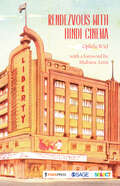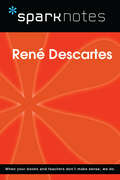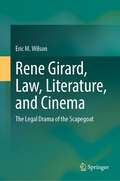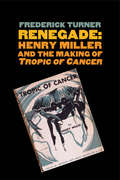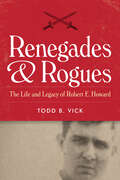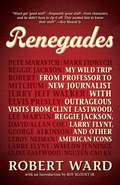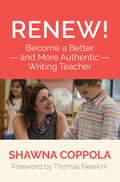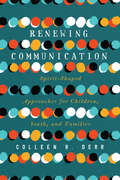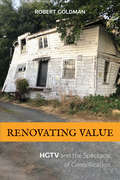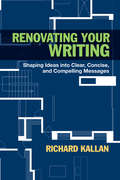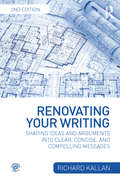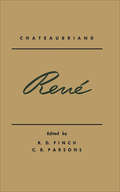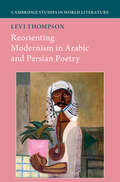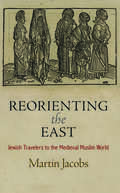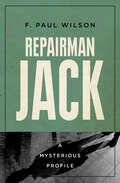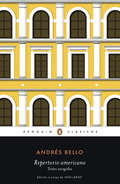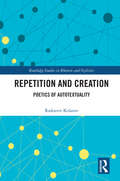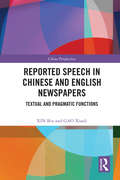- Table View
- List View
Renaissance Shakespeare/Shakespeare Renaissances: Proceedings of the Ninth World Shakespeare Congress
by Stanley Wells Sukanta Chaudhuri Randall Martin Brian Walsh Ros King James J. Marino Graham Holderness Barry Freeman Shaul Bassi Ann Jennalie Cook Emma Depledge Jean-Christophe Mayer Patrick Lonergan Courtney Lehmann Sharon O'Dair Poonam Trivedi Supriya Chaudhuri Darryl Chalk M. A. Katritzky Jill L. Levenson Margaret Shewring Hersh Zeifman Robert Darcy Joel Rodgers Atsuhiko Hirota Kimberly R. West Richard Fotheringham Eleanor Collins Martin Hilský Vlasta Gallerová Karel Kríž Robert Sturua Galz Engler Madalina Nicolaescu Kaori Kobayashi Zeno Ackermann Tina Krontiris Emily Oliver Carla Della Gatta Cristiane Busato Smith Anna Cetera Bi-Qi Beatrice LeiSelected contributions to the Ninth World Shakespeare Congress, which took place in July 2011 in Prague, represent the contemporary state of Shakespeare studies in thirty-eight countries worldwide. Apart from readings of Shakespeare’s plays and poems, more than forty chapters map Renaissance contexts of his art in politics, theater, law, or material culture and discuss numerous cases of the impact of his works in global culture from the Americas to the Far East, including stage productions, book culture, translations, film and television adaptations, festivals, and national heritage. The last section of the book focuses on the afterlife of Shakespeare in the work of the leading British dramatist Tom Stoppard. Published by University of Delaware Press. Distributed worldwide by Rutgers University Press.
Renaissance Syntax and Subjectivity: Ideological Contents of Latin and the Vernacular in Scottish Prose Chronicles
by John C. LeedsThe relationship between Latin and the Scots vernacular in the chronicle literature of 16th-century Scotland provides the topic for this study. John Leeds here shows how the disposition of grammatical subjects, in the radically dissimilar syntactic systems of humanist neo-Latin and Scots, conditions the way in which "the subject" (i.e., the human individual) and its actions are conceived in the writing of history. In doing so, he extends the boundaries of existing critical literature on early modern "subjectivity" to include the subject of grammar, analyzing its incorporation into narrative sentences and illuminating the ideological contents of different systems for its deployment. Though focused on the chronicles of Renaissance Scotland, the argument can in principle be applied to the entire range of Latin-vernacular relations during the early modern period. While examining the intellectual culture of early modernity, Leeds also takes aim, at every stage of his argument, at the semiotic and social-constructionist orthodoxies that dominate the humanities today. Against the notion that human subjects are "discursive constructs," he argues for the subordination of discourse to realities, both material and immaterial, that are external to language. As part of this argument, he proposes a view of neo-Latin humanism as a resistance to the onset of modernity, arguing that Latin prose provides options (at once syntactic, ideological, and ontological) that vernacular culture has, to its considerable detriment, foreclosed. In sum, Leeds advocates a renewed and theoretically-informed commitment to the humanism that the humanities themselves have been at such pains, during the last scholarly generation, to depreciate.
Renaissance Transactions: Ariosto and Tasso
by Valeria FinucciThe controversy generated in Italy by the writings of Ludovico Ariosto and Torquato Tasso during the sixteenth century was the first historically important debate on what constitutes modern literature. Applying current critical theories and tools, the essays in Renaissance Transactions reexamine these two provocative poet-thinkers, the debate they inspired, and the reasons why that debate remains relevant today. Resituating these writers' works in the context of the Renaissance while also offering appraisals of their uncanny "postmodernity," the contributors to this volume focus primarily on Ariosto's Orlando furioso and Tasso's Gerusalemme liberata. Essays center on questions of national and religious identity, performative representation, and the theatricality of literature. They also address subjects regarding genre and gender, social and legal anthropology, and reactionary versus revolutionary writing. Finally, they advance the historically significant debate about what constitutes modern literature by revisiting with new perspective questions first asked centuries ago: Did Ariosto invent a truly national, and uniquely Italian, literary genre--the chivalric romance? Or did Tasso alone, by equaling the epic standards of Homer and Virgil, make it possible for a literature written in Italian to attain the status of its classical Greek and Latin antecedents? Arguing that Ariosto and Tasso are still central to the debate on what constitutes modern narrative, this collection will be invaluable to scholars of Italian literature, literary history, critical theory, and the Renaissance.Contributors. Jo Ann Cavallo, Valeria Finucci, Katherine Hoffman, Daniel Javitch, Constance Jordan, Ronald L. Martinez, Eric Nicholson, Walter Stephens, Naomi Yavneh, Sergio Zatti
Renaissance Woman: Constructions of Femininity in England
by Kate AughtersonRenaissance Woman: A Sourcebook is an invaluable collection of accounts of women and femininity in early modern England. The volume is divided thematically into nine sections, each with an accessible introduction, notes on sources and an annotated bibliography. The sections are:* Theology * Biology * Conduct * Sexuality and Motherhood * Politics and Law * Education * Work * Writing and Speaking * Feminism Renaissance Woman: A Sourcebook brings together sources ranging from medical documents and political pamphlets to sermons and the Bible, as well as literary sources. Providing a historical context to issues of gender in the Renasissance, it will be essential reading for students of the period, gender studies and cultural history.
Renaut de Bâgé, 'Le Bel Inconnu': ('Li Biaus Descouneüs'; 'The Fair Unknown') (Routledge Revivals)
by Karen FrescoOriginally published in 1992, Le Bel Inconnu edited and with an introduction by Karen Fresco, presents on facing pages the original Old French text and the English translation of this significant medieval romance poem by Renaut de Bâgé The extensive introduction to the text includes an exploration into the life of the author, Renaut de Bâgé, as well as a detailed assessment of the poem, its sources and influences, and the broader genre of medieval romance. It is also equipped with close textual notes, an index of proper nouns, and an examination of Renaut’s Song Leals Amors Q’est Dedanz Fin Cuer Mise, including the musical scores.
Rendering French Realism
by Lawrence R. SchehrRealist novels are usually seen as verisimilar representations of the world, and even when that verisimilitude is critically examined (as it has been by Marxist and feminist critics), the criticism has referred to extra-literary matters, such as bourgeois ideology or defects in the portrayal of women. This book takes as its thesis that the point defining realism is the point at which the processes of representation break down, a sort of black hole of textuality, a rent in the tissue. The author argues that our notions of continuity, of readability, of representability, or our ideas about unity and ideological shift—or even our notions of what is hidden, occulted, or absent—all come from the nineteenth-century realist model itself. Instead of assuming representability, the author argues that we should look at places where the texts do not continue the representationalist model, where there is a sudden falling off, an abyss. Instead of seeing that point as a shortcoming, the author argues that it is equal to the mimetic successes of representation. After an initial chapter dealing with the limits and ruptures of textuality, the book considers the work of Stendhal, from its early state as a precursor to the later realism to La Chartreuse de Parme, which shows how the act of communication for Stendhal is always made of silences, gaps, and interruptions. The author then reads several works of Balzac, showing how he, while setting up the praxes of continuity on which his oeuvre depends, ruptures the works at various strategic points. In a chapter entitled "Romantic Interruptions," works of Nerval and the younger Dumas, seemingly unrelated to the realist project, are shown to be marked by the ideological, representational, and semiotic assumptions that produced Balzac. The book concludes with Flaubert, looking both at how Flaubert incessantly makes things "unfit" and how critics, even the most perspicacious postmodern ones, often try to smooth over the permanent crisis of rupture that is the sign of Flaubert's writing.
Rendezvous with Hindi Cinema
by Ophelie WielIndian cinema hasn’t been as much talked about worldwide since probably the first works of Satyajit Ray which were shown at the Cannes Film Festival in the 1950s-1960s. Renewed interest for the biggest film industry in the world doesn’t mean its complexity is well understood abroad or even inside India itself. Bollywood especially seems to have taken over all the other industries as if to become the only representative for Indian cinema; and Hindi cinema struggles to be known as anything else than Bollywood. Still, you’d probably have to go back to the 1970s to see, in Bombay films, such uproar and desire to give the audiences a more diverse cinema, either by renewing the song-and-dance formula, or by simply negating it. In this interview-based book, Hindi film technicians, artists and industrialists from all horizons and all age groups speak in detail about their work, and give their input on the present situation of Hindi cinema as well as its future. Whether this future will really be bright or not, one could not say; but that Hindi cinema is now living fascinating times definitely cannot be denied.
Rene Descartes (SparkNotes Philosophy Guide)
by SparkNotesRene Descartes (SparkNotes Philosophy Guide) Making the reading experience fun! SparkNotes Philosophy Guides are one-stop guides to the great works of philosophy–masterpieces that stand at the foundations of Western thought. Inside each Philosophy Guide you&’ll find insightful overviews of great philosophical works of the Western world.
Rene Girard, Law, Literature, and Cinema: The Legal Drama of the Scapegoat
by Eric M. WilsonThis book is the first monograph to critically evaluate the work of the literary scholar René Girard from the perspectives of Law and Literature and Law and Film Studies, two of the most multidisciplinary branches of critical legal theory. The central thesis is that Girard’s theory of the scapegoat mechanism provides a wholly new and original means of re-conceptualizing the nature of judicial modernity, which is the belief that modern Law constitutes an internally coherent and exclusively secular form of rationality. The book argues that it is the archaic scapegoat mechanism – the reconciliation of the community through the direction of unified violence against a single victim – that actually works best in explaining all of the outstanding issues of Law and Literature in both of its sub-forms: law-as-literature (the analysis of legal language and practice exemplified by literacy texts) and law-in-literature (the exploration of issues in legaltheory through the fictitious form of the novel). The book will provide readers with: (i) a useful introduction to the most important elements of the work of René Girard; (ii) a greater awareness of the ‘hidden’ nature of legal culture and reasoning within a post-secular age; and (iii) a new understanding of the ‘subversive’ (or ‘enlightening‘) nature of some of the most iconic works on Law in both Literature and Cinema, media which by their nature allow for the expression of truths repressed by formal legal discourse.
Renegade
by Frederick TurnerThough branded as pornography for its graphic language and explicit sexuality, Henry Miller’sTropic of Canceris far more than a work that tested American censorship laws. In this riveting book, published to coincide with the fiftieth anniversary ofTropic of Cancer's initial U. S. release, Frederick Turner investigates Miller’s unconventional novel, its tumultuous publishing history, and its unique place in American letters. Written in the slums of a foreign city by a man who was an utter literary failure in his homeland,Tropic of Cancerwas published in 1934 by a pornographer in Paris, but soon banned in the United States. Not until 1961, when Grove Press triumphed over the censors, did Miller’s book appear in American bookstores. Turner argues thatTropic of Canceris “lawless, violent, colorful, misogynistic, anarchical, bigoted, and shaped by the same forces that shaped the nation. ” Further, the novel draws on more than two centuries of New World history, folklore, and popular culture in ways never attempted before. How Henry Miller, outcast and renegade, came to understand what literary dynamite he had within him, how he learned to sound his “war whoop” over the roofs of the world, is the subject of Turner’s revelatory study.
Renegades & Rogues: The Life and Legacy of Robert E. Howard
by Todd B. VickThis biography of the creator of Conan the Barbarian is &“deep dive work,&” in which &“this &‘mysterious&’ Texas scribe gets his most complete story arc told&” (Houston Press). Robert E Howard&’s most famous creation, Conan the Barbarian, is an icon of popular culture. In hundreds of tales detailing the exploits of Conan, King Kull, and others, Howard helped to invent the sword and sorcery genre. Todd B. Vick delves into newly available archives and probes Howard&’s relationships, particularly with schoolteacher Novalyne Price, to bring a fresh, objective perspective to Howard's life. Like his many characters, Howard was an enigma and an outsider. He spent his formative years visiting the four corners of Texas, experiences that left a mark on his stories. He was intensely devoted to his mother, whom he nursed in her final days, and whose impending death contributed to his suicide in 1936 when he was just thirty years old.Renegades & Rogues is an unequivocal journalistic account that situates Howard within the broader context of pulp literature. More than a realistic fantasist, he wrote westerns and horror stories as well, and engaged in avid correspondence with H. P. Lovecraft and other pulp writers of his day. Vick investigates Howard&’s twelve-year writing career, analyzes the influences that underlay his celebrated characters, and assesses the afterlife of Conan, the figure in whom Howard&’s fervent imagination achieved its most durable expression. &“A tour de force.&” ―Modern Age &“A compelling read.&” —S. T. Joshi, author of I Am Providence: The Life and Times of H. P. Lovecraft
Renegades: My Wild Trip from Professor to New Journalist with Outrageous Visits from Clint Eastwood, Reggie Jackson, Larry Flynt, and other American Icons
by Robert WardAfter spending time as a professor in upstate New York, Robert Ward decided to give journalism a try.What followed were two decades of assignments for New Times, GQ, SPORT, Rolling Stone, and other publications, covering the biggest stars of the sporting, music, art, and film worlds. This collection includes Ward's celebrated story on Reggie Jackson that nearly tore the New York Yankees apart (and was later brought to life in an ESPN miniseries "The Bronx Is Burning"); a profile of the "outlaw" country music movement of Willie Nelson, Waylon Jennings, Jerry Jeff Walker, and David Allan Coe; and an insightful feature on Hustler publisher Larry Flynt as a young pornographer that almost cost Ward his life.Also included are essays about the former premier of Vietnam Nguyen Cao Ky trying to adjust to life in California; an aging Lee Marvin dealing with the survivor's guilt from his time in World War II; and profiles of LeRoy Neiman, Robert Mitchum, and a variety of fringe characters on the American scene.
Renew!: Become a Better and More Authentic Writing Teacher
by Shawna CoppolaWhen was the last time you shook up your writing instruction? In Renew!: Become a Better and More Authentic Writing Teacher, author Shawna Coppola builds on the premise that our students are ever-changing, and so is our collective knowledge base. Instructional strategies that have worked in the past may need to evolve accordingly. Coppola guides K-8 writing teachers with a three-part framework for Rethinking, Revising, and Renewing their approach'sand finding new energy along the way. Using the framework, Renew! examines the most pervasive educational practices in writing instruction and poses questions that guide teachers to revise those practices to ensure they are effective for all students. Coppola believes the work is challenging, yet critical, referencing R. Buckminster Fuller's Knowledge Doubling Curve: According to Fuller's paradigm, the amount of time it takes for us to increase our collective knowledge base by 100 percent will continue to shrink the older we get. If this is true'sor even close to being true'show can we, as educators, ever feel satisfied with teaching our students the same concepts, using the same methodologies and practices, that we have in the past? The book offers a road map for renewing key aspects of our practice, including: How we teach the writing process: Over time and frequent usage, some of our favorite teaching strategies can become rigid. Coppola gives a candid account of how her enthusiasm for the writing process as an undergraduate led her to teach writing for years as a set of pre-determined steps. Now she teaches that there are many variations of the writing process, and many twists and turns along the path. One foundational strategy used is opening up her own process as a writer'sand her writer's notebook'sto students and encouraging them to think and talk about their process with classmates. What we mean by Writing: Coppola argues that drawing isn't an accompaniment to writing; it is writing. Its another form of composition through which students can tell stories, convey ideas, and engage readers. The book is full of visual compositions by students as well as Shawna's wonderfully simple and evocative sketches from her writer's notebook. The tools we use to teach writing: The most ubiquitous tools used to teach writing'sfrom anchor charts to graphic organizers to sentence starters etc.'stend to be teacher-centric rather than student-centric. Renew! invites students into the process of constructing tools that are meaningful and helpful to them. The book includes a range of examples of tools built collaboratively with students. How we assess and evaluate student writing: Coppola draws a distinction between assessment'swhich should be an interactive conversation with students'sand evaluation, which is about judging and categorizing what students know and can do. Renew! offers a range of examples and resources that illustrate effective feedback for student writers, including online videos of teacher-student and peer-to-peer conferences. Renew! also offers ideas for how teachers can nurture their own writing lives and thus reinvigorate their instructional practice. Through rethinking, revising, and renewing their practice, teachers can not only strengthen students' skills as writers, but also nurture students to become critical thinkers, problem solvers, and risk takers in the classroom and in our rapidly-changing world.
Renewing Communication: Spirit-Shaped Approaches for Children, Youth, and Families
by Colleen R. DerrWe are constantly communicating.Renewing Communicationtheories of human developmenthow to understand your audience and contextsetting specific goalsnonverbal communicationeffective techniquesusing creativityevaluation and assessment
Renewing Rhetoric's Relation to Composition: Essays in Honor of Theresa Jarnagin Enos
by Shane BorrowmanRenewing Rhetoric’s Relation to Composition comprehensively examines the development of rhetoric and composition, using the writings of Theresa Jarnagin Enos as points of departure for studies of broader trends. Chapters explore such topics as the historical relations of rhetoric and composition, their evolution within programs of study, and Enos’s research on gender. The volume presents the growing disjunction between rhetoric and composition and paints a compelling picture of the current state of both disciplines as well as their origins. This volume acknowledges the influential role that Theresa Enos has had in the writing and rhetoric disciplines. Her career provides benchmarks for plotting developments in rhetoric and composition, including the evolving relations between the two. This collection offers a tribute to her work and to the new directions in the discipline stemming from her research. With an all-star line-up of contributors, it also represents the state of the art in rhetoric and composition scholarship, and it will serve current and future scholars in both disciplines.
Renovating Value: HGTV and the Spectacle of Gentrification
by Robert GoldmanHGTV has perfected stories about creating and capturing value in the housing market. But according to Robert Goldman, this lifestyle network’s beloved flagship programs, Flip or Flop, Property Brothers, and Fixer Upper—where people revitalize modern spaces and reinvent property values—offer “fairy tales” in the wake of the 2008 economic crisis. The cable channel’s seductive, bingeable programs may show how to find and extract value from properties, but, in fact, they insidiously ignore the realities of the real estate and mortgage markets, housing inequality, gentrification, economic insecurity, and even homelessness. In effect, HGTV has turned house flipping into a master narrative about getting ahead in America during an era of otherwise uneasy economic prospects. HGTV pictures its insular moral economy as an alternative to a crisis-ridden neoliberal finance system that shaped landscapes of foreclosure and financial uncertainty for millions of households. Renovating Value explores the circuitry of consumer credit and debt, and a rent-gap model of gentrification that charts a path to the rehabilitation of Value. Goldman shrewdly critiques the aspirational myth of adding value to a home simply by using imagination, elbow grease, and aesthetic know-how.
Renovating Your Writing
by Richard KallanWhether outlining a persuasive speech or looking to improve overall organizational skills, Renovating Your Writing outlines the principles of effective composition and then engages the reader with constant revision and editing practices to improve writing skills at school, work, and home . This enlightening text provides readers with unique strategies, tactics, and tips needed to improve their ability to critique and self-revise their work. Kallan introduces and emphasizes to readers the difference between the act of writing and the informed practice of writing.
Renovating Your Writing: Shaping Ideas and Arguments into Clear, Concise, and Compelling Messages
by Richard KallanRenovating Your Writing outlines the principles of effective composition by focusing on the essential skill set and mindset every successful writer must possess. Now in its second edition, this novel text provides readers with unique strategies for crafting and revising their writing, whether for school, work, or play. The new edition emphasizes, in particular, the importance of the writer embracing a rhetorical perspective, distinguishing between formal and social media compositional styles, and appreciating the effort needed to produce clear, concise, and compelling messages.
René
by C. R. Parsons François-René de Chateaubriand R. D. FinchIf the writings of Chateaubriand, one above all is both most representative of its author and most significant for reader and student alike. René, a milestone of literature, presents the first genuine and complete picture of that state of spiritual frustration and moral isolation known as le mal du siècle, its causes, symptoms, ravages, and cure.Chateaubriand, a prodigious artist with an incomparable style, enjoys the further distinction of having fused in his work the end of one epoch and the beginning of another. It is sometimes forgotten that these epochs are not only French but also European in scope, and their reverberations as expressed by Chateaubriand have affected almost every subsequent writer of importance up to the present. Chateaubriand is often called the father of romanticism. It may be claimed with equal reason that he is the grandfather of the neo-romanticism of our time.This edition of René contains, as well as a full introduction, notes covering the allusions to place names, events, and personages, and a complete vocabulary.
Reorienting Modernism in Arabic and Persian Poetry (Cambridge Studies in World Literature)
by Levi ThompsonRe-orienting Modernism in Arabic and Persian Poetry is the first book to systematically study the parallel development of modernist poetry in Arabic and Persian. It presents a fresh line of comparative inquiry into minor literatures within the field of world literary studies. Focusing on Arabic-Persian literary exchanges allows readers to better understand the development of modernist poetry in both traditions and in turn challenge Europe's position at the center of literary modernism. The argument contributes to current scholarly efforts to globalize modernist studies by reading Arabic and Persian poetry comparatively within the context of the Cold War to establish the Middle East as a significant participant in wider modernist developments. To illuminate profound connections between Arabic and Persian modernist poetry in both form and content, the book takes up works from key poets including the Iraqis Badr Shakir al-Sayyab and Abd al-Wahhab al-Bayati and the Iranians Nima Yushij, Ahmad Shamlu, and Forough Farrokhzad.
Reorienting the East: Jewish Travelers to the Medieval Muslim World (Jewish Culture and Contexts)
by Martin JacobsReorienting the East explores the Islamic world as it was encountered, envisioned, and elaborated by Jewish travelers from the Middle Ages to the early modern period. The first comprehensive investigation of Jewish travel writing from this era, this study engages with questions raised by postcolonial studies and contributes to the debate over the nature and history of Orientalism as defined by Edward Said.Examining two dozen Hebrew and Judeo-Arabic travel accounts from the mid-twelfth to the early sixteenth centuries, Martin Jacobs asks whether Jewish travelers shared Western perceptions of the Islamic world with their Christian counterparts. Most Jews who detailed their journeys during this period hailed from Christian lands and many sailed to the Eastern Mediterranean aboard Christian-owned vessels. Yet Jacobs finds that their descriptions of the Near East subvert or reorient a decidedly Christian vision of the region. The accounts from the crusader era, in particular, are often critical of the Christian church and present glowing portraits of Muslim-Jewish relations. By contrast, some of the later travelers discussed in the book express condescending attitudes toward Islam, Muslims, and Near Eastern Jews. Placing shifting perspectives on the Muslim world in their historical, social, and literary contexts, Jacobs interprets these texts as mirrors of changing Jewish self-perceptions. As he argues, the travel accounts echo the various ways in which premodern Jews negotiated their mingled identities, which were neither exclusively Western nor entirely Eastern.
Repairman Jack (Mysterious Profiles)
by F. Paul WilsonThe New York Times–bestselling author of The Keep tells the real and fictional origins of the mysterious man who battles criminals and the supernatural. In 1984, Repairman Jack debuted in F. Paul Wilson&’s horror thriller The Tomb. Jack would go on to star in twenty-three novels, ten short stories, and a graphic novel. But how did the antithesis of James Bond and Jason Bourne get his start in the battle between good and evil? In this essay, Wilson lets his readers in on how his beloved hero came to be. Wilson begins his personal story after he scored a hit with The Keep, when he found his inspiration for his next book in a dream. He discusses selecting and researching a monster, as well as developing Jack, his supporting cast, and settling on a villain. He also shares how the first title in the series came to be—it wasn&’t always The Tomb. Wilson closes with Jack&’s fictional backstory and his thoughts on Jack&’s potential future—if there is one . . .Praise for Repairman Jack &“One of the all-time great characters in one of the all-time great series.&” —Lee Child, #1 New York Times–bestselling author of the Jack Reacher series &“Repairman Jack is one of the most original and intriguing characters to arise out of contemporary fiction in ages. His adventures are hugely entertaining.&” —Dean Koontz, #1 New York Times–bestselling author of Strangers
Repertorio americano: Textos escogidos
by Andrés BelloLa gran antología de textos del primer humanista de América, realizada por el historiador Iván Jaksic <P><P> Además de ser una de las figuras más importantes en la construcción del orden político en la Hispanoamérica del siglo XIX, Andrés Bello fue, sin duda alguna, uno de los fundadores intelectuales de Chile. Su obra, como señala el historiador Ivan Jaksic, a cargo de la selección, <P><P> Repertorio americano reune sus textos más destacados en tres áreas. Un primer capítulo dedicado a la lengua y a la literatura, en donde se encuentra su emblemática introducción a la gramática de la lengua castellana para el uso de los americanos; un segundo capítulo que reune sus escritos sobre educación e historia, entre ellos el discurso de inauguración de la Universidad de Chile y sus estudios de jurisprudencia; finalmente, sus escritos sobre derecho, política y relaciones internacionales en donde el intelectual venezolano piensa y analiza distintos modos de gobernar en la nueva América, incluida su exposición de motivos del Código Civil, del que fue redactor e impulsor.
Repetition and Creation: Poetics of Autotextuality (Routledge Studies in Rhetoric and Stylistics)
by Radosvet KolarovThis book advances the notion of autotextuality, the dialogue between works in an author’s oeuvre, and the ways in which new texts are created in self-repetition through the tracing and revisiting of past texts and the subsequent uncovering of undisclosed meanings, unexhausted constructive principles, and alternative versions. Kolarov draws on cognitive models, such as dual coding theory and conceptual blending, to substantiate a theory of autotextuality and build on previous work on self-repetition and difference to highlight the notion of “discursive desire,” in which new meanings are generated through repetition, and its distinct relationship to creativity. Drawing on analyses of well-established works in Bulgarian as well as the established oeuvres of such authors as Gogol, Dostoevsky, Kafka, and Baudelaire, the volume explores key themes in autotextuality such as the functions of creative memory, the connections between word and image, and the hermeneutic relationships and steps of transformation between texts. This innovative work addresses topical questions of importance in literary theory today and will be of interest to students and scholars in literary studies and related areas of study within such fields as cognitive science, quantum mechanics, and psychology.
Reported Speech in Chinese and English Newspapers: Textual and Pragmatic Functions (China Perspectives)
by XIN Bin GAO XiaoliReported speech is a universal form across human languages. However, previous studies have tended to be limited because they mostly emphasize on the form and authenticity of reported speech, while its discourse and pragmatic functions have largely been ignored. Meanwhile, the studies mainly focus on English, with a comparative perspective with other languages largely missing. Acknowledging these limitations, this book analyzes the textual and pragmatic functions of reported speech in Chinese and English. The authors build a corpus comprising of twelve Chinese and English newspapers, including China Daily and The New York Times. They examine the classification and distribution of reported speech, the form and function in different news genres and contexts, and the socio-pragmatic interpretation of reported speech in news and other issues. This title can enrich comparative linguistic research, verify the feasibility of combining critical linguistics and corpus technology, and help improve the production and understanding of news reports. Students and scholars of critical discourse analysis, comparative linguistics, corpus linguistics, as well as communication studies will find this to be an essential guide.
